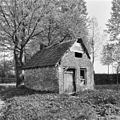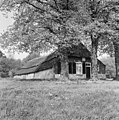History of Sint-Oedenrode
This article includes a list of general references, but it lacks sufficient corresponding inline citations. (June 2019) |


Etymology
The following story is based on a popular belief (saga) [3][4][5]
According to legend, Sint-Oedenrode owes its name to Saint Oda. The saga goes as follows: This woman was a mythical blind born
Eventually she arrived in
History
[9][10][11][12][13][14][15][16][17][18][19][20][21][22][23][24][25]
Prehistory and Roman times
The first traces of human presence date from the period between 10,000 and 9,000 BC. The first settlements whose remains were found during the excavation of the Dommel riverbank near the Hazenputten in the Vresselse Bossen, (Nijnsel), date from a period between 9000 and 8000 BC. In the Bronze Age the first farmers settled in and around Sint-Oedenrode. About the following era is not much known.
First records of the settlement called Rhode date from 500. Sint-Oedenrode was a small settlement on an elevated place near the river Dommel. The settlements on both riverbanks (Rhode and Eerschot) merged into one larger settlement.
In the 11th century the Lords of Rhode built a castle on the elevated area (during excavations in 2005 remains of the castle were uncovered, proving the early records to be valid). The Eerschot part of the settlement constructed the first church (the church has been rebuilt many times over the centuries; the early base can still be seen in the church which is nowadays named Knoptoren which means Bud Tower).
The settlement thrived and became an important place in the region. Sint-Oedenrode was granted

County of Rode
The first reclamation took place in the early Middle Ages on fertile woodland along the Dommel. The oldest core and the original parish of Sint-Oedenrode is located in Eerschot, now part of Sint-Oedenrode. In this place were the Lords of Rode established before they moved further along the Dommel, where they built their castle "Rode". In the earliest period in the early Middle Ages, Sint-Oedenrode formed the core of the county Rode. There is no exact size of this county known, but following the Roois
. They were able to appeal at the so-called main court in Sint-Oedenrode.During this period, the inhabitants of these villages were therefore designated by the name Rodenaren and received their land rights by Roois law. The Roois law was in 1547 for the first time been put in writing. But part of the customary law, such as inheritance rights and Roois fief rights which are already mentioned in 1312, is according to historian Martin van Asseldonk possibly dating back to the days of the county.
The Lords of Rode possessed goods around the Castle of Rode, but also in Eerschot, Schijndel, Veghel, Erp, Son and Liempde. There were real property of the
The county Rode is possibly the precursor of the quarter Peelland.
In the 14th century a small castle was built named Strijpe, it was later expanded in the 19th century and renamed
Duchy of Brabant
With the sale of the county Rode by Otto II, Count of Guelders to Henry I, Duke of Brabant, due to an old agreement, in 1231 Sint-Oedenrode becomes a part of the Duchy of Brabant as a part of the Meierij (Bailiwick) of 's-Hertogenbosch. As a consequence of this agreement and as a compensation of the loss of their sovereignty the city becomes the administrative capital of the first known quarter Peelland.
In 1232 Sint-Oedenrode got freedom rights. From then on Sint-Oedenrode and the nearby located Eerschot is referred to as De Oude Vrijheid (The Old Freeheerlijkheid). The new town had good natural defenses, as it was situated in a bend of the Dommel and was surrounded by the marshy fields called the Dommelbeemden.
During this era the Sint-Oedenrode as capital of Peelland prospers. In 1355 it joins a covenant of Brabant cities. The city acquired rights and because of the administrative function Sint-Oedenrode attracted new craftsmen, who were especially settling around the large oblong marketplace. Also the clergy and nobility built several castles and fortified farms in Sint-Oedenrode, which mainly served as country stays for various noble families of the Meierij. An important estate at that time was the "Hertog Jaaghuis" (Duke's hunting lodge), which is built on the site of the former castle. Its foundations were excavated in 2004.
Economic growth is reflected in the creation of various structures, such as the Knoptoren of the
at the Oda church in 1498. This chapter church was served by canons living in large private mansions. The chapter joined in 1505 the Brabants chapter covenant.The booming economy of Sint-Oedenrode receives several blows during the 16th century. During the
The
- In 1572 State troops under the Duke of Holstein plundered the city.
- In 1576 the States occupier of Zaltbommel destroyed several houses in Rode.
- After which the States garrison of Heusden destroyed another hundred and ten houses in 1581.
- A disastrous year was 1583 when State troops under Baron of Den Bosch, so it would not fall to the republic's hordes.
- In 1587 the city was again plundered by State troops under the Count of Hohenlohe.
The consecutive disasters in the late 16th century were devastating to the development of the city.

Staats-Brabant
Since 1648 is Sint-Oedenrode part of the
French period and Kingdom of the Netherlands
The French led by General

World War II
During the
During the final months of occupation the mayor (appointed by the Queen Wilhelmina of the Netherlands) was sacked and replaced by a pro-German mayor. The reasons for the sacking were that the central Distribution Office was plundered from blank distribution cards that were necessary to get coupons for males who were hiding from the Arbeitseinsatz (compulsory labour in the German war industry) and were using fake names. Also the mayor tried to sabotage the Arbeitseinsatz.
With the beginning of

In September 1944 the liberation of Sint-Oedenrode came during Operation Market-Garden envisaged by Field Marshal Bernard Law Montgomery. The US 101st Airborne Division liberated the Town of Sint-Oedenrode (the 'Market' part) after para droppings in the fields in the vicinity. They were followed by the British XXX Army Corps (the 'Garden' part). For a brief time the 18th-century castle Henkenshage was used as allied HQ.
The British left 150 comrades behind, the Americans 125. Twenty-two British soldiers are buried at the General Cemetery in Sint-Oedenrode. Most of the British are reburied at the
On September 16, 1994 101st Airborne veterans revealed a war monument 'Monument for the Dutch'. The monument is a gift from the veterans to the civilians who fought alongside of the US troops, much to surprise and relief of the US soldiers. The inscription on the monument is in English and reads "Dedicated to the people of the Corridor by the veterans of the 101st Airborne Division, in grateful appreciation of their courage, compassion and friendship". The monument can be found alongside the road 'Corridor' which was constructed after the war between key points of the actual Corridor: the allied supply route from Eindhoven to Nijmegen.
Post-war era
In the twentieth century mainly the growth of
Gallery
This section contains an unencyclopedic or excessive gallery of images. |
-
"Borchmolen" (Water mill) at the "Borchmolendijk"
-
"De Grote Laar" as seen from the back, Nijnselseweg
-
"De Grote Laar" as seen from the front, Nijnselseweg
-
Mill "De Koevering" destroyed in 1944[28]
-
Forge, 1905
-
Old post office with staff residence, market square,
-
Sint Paulus Hospice, 1434, Sint-Oedenrode
-
Farm House, Boskant 1968
-
Emmaus [29] House, Sint-Oedenrode
-
Castle Dommelrode, December 1960, before restoration
-
Northwest side of the market square, Sint-Oedenrode, March 1964
-
Old town house with forge, turned museum, at 't Kofferen, Sint-Oedenrode
-
War graves in Sint-Oedenrode
-
Old town house, Sint-Oedenrode
-
Former grain mill, burned down 1932. January 1968
-
Old baking house, May 1970
-
Farm house, Vresselse weg, May 1970
-
Farm house, Vresselse weg, May 1970
-
Castle Henkenshage, 1978
-
Castle Henkenshage
-
Castle Henkenshage, June 1905
-
Castle Henkenshage, June 1905
-
Castle Henkenshage, June 1905
-
Castle "De Bocht" or "Dommelrode", December 1960
-
market square, June 1968
-
market square, June 1968
-
market square, June 1968
-
market square, June 1968
-
Museum with old forge, 't Kofferen, June 1968
-
Kerkdijk, June 1968
-
Kerkdijk, June 1968
-
St. Oda factory, December 1980
-
Hay shed, Lieshoutseweg, Nijnsel, September 7, 1984
-
Traditional interior of Brabantian farm house, Sint-Oedenrode
-
Interior of Brabantian farm house, Sint-Oedenrode, 1905
-
Interior of Brabantian farm house, Sint-Oedenrode, 1905
-
Porter's Lodge, Sint-Oedenrode
-
Old Brabant style farm stead, Liehoutseweg, 15 April 1942
-
Old Brabant style farm stead, Lieshoutseweg, April 15, 1942
-
Old Brabant style farm stead, Lieshoutseweg, September 7, 1984
-
Calvary at Sint Martinus cemetery
-
Sint Martinus Church, Sint-Oedenrode
-
House "De Kolk", before restoration, May 1965
-
Children bring soldiers of the Irish Guards apples, 18-09-1944. In recognition of the courage, friendship and the sympathy which the population gave to the veterans of the U.S. 101st Airborne Division, the monument to thank the Dutch was founded exactly fifty years after Market Garden in Sint-Oedenrode.
-
East side of the market square, Sint-Oedenrode, March 1964
References
- ^ "Sint-oedenrode - Toerisme". Toeristen informatie. Archived from the original on 2013-11-03. Retrieved 2013-11-06.
- ^ ROOIJ, W. VAN E.A., 750 Jaar Stadsrechten Sint-Oedenrode in 1982.
- ^ "Oda van Sint-Oedenrode". G-Geschiedenis. 2012-11-27. Retrieved 2013-11-06.
- ^ "Oda (eind 7e-1ste helft 8e eeuw)". 2013-01-22. Retrieved 2013-11-06.
- ^ "Geschiedenis". Retrieved 2013-11-06.
- ^ "27 november – Oda van Sint-Oedenrode - G/Geschiedenis".
- ^ djr (4 October 2018). "Digitaal Vrouwenlexicon van Nederland". resources.huygens.knaw.nl.
- ^ "リルジュリカバリィエッセンスは効果なし?【口コミ暴露】楽天Amazonは販売店としてダメ". www.schutterijstoda.com.
- ^ MOMMERS, MR. A.R.M., St. Oedenrode. Van Oude Tijden tot Heden.
- ^ VISSER, R.W.A.M. & ROOIJ, W.W. VAN De mantel van Sint Maarten. De bouw en restauratie van de Sint-Martinuskerk in Sint-Oedenrode
- ^ "Heemkundekring Sint-Oedenrode". Retrieved 2013-11-06.
- ^ BRABANT FRENKEN, A.M., - DOCUMENTEN BETREFFENDE DE KAPITTELS VAN - HILVARENBEEK, SINT OEDENRODE EN OIRSCHOT
- ^ "Kasteel Rode te Sint-Oedenrode / Noord-Brabant Nederland". Kastelen in Nederland. Retrieved 2013-11-06.
- ^ "BHIC". Retrieved 2013-11-06.
- ^ "Sint-Oedenrode". Thuis in Brabant. Retrieved 2013-11-06.
- ^ GAAL, FRANS VAN [JACQUES VAN EEKELEN - LISTS & RUUD VERMEER - PHOTOGR.]. Een monumentaal oorlogsverhaal. De Meierij tussen 1939 en 1945 in ruim 100 gedenktekens.
- ^ "Historie | De Knoptoren - Cateringbemiddeling & Horeca-Exploitatie, Sint-Oedenrode". Retrieved 2013-11-06.
- ^ "Oedenrode". Archived from the original on 2013-11-04. Retrieved 2013-11-06.
- ^ BREUGEL, AUG. VAN E.A., - Gids voor de Tentoonstelling Van Steentijd en Brabantse Muts Kasteel Henkenshage Sint-Oedenrode. 1964
- ^ BROCK, A.C. Beschryving der Vryheid St. Oden Rode. Manuscripten uit 1832 over de geschiedenis van Sint-Oedenrode [2 Vols. in 1].
- ^ C.S.M. Heesters W.; Rademaker - Geschiedenis Van Sint Oedenrode
- ^ Dr. C.S.M. Heesters W.; Rademaker - Sint-oedenrode. Zwerftocht Door Een Boeiend Verleden.
- ^ Dr. C.S.M. Heesters W.; Rademaker - Geschiedenis Van Sint-oedenrode (bijdragen Tot De Geschiedenis Van Het Zuiden Van Nederland, Dl. Xxiv)
- ^ BAR, DE G. DE M. V. C. EN JHR. J.J.G. B. V. B., A.M.J. - Met slaande trom. Driehonderd jaar soldatenfamilie. Coehoorn, de Girard de Mielet van Coehoorn, Beelaarts van Blokland.
- ^ BEEX, G.A.C. E.A., - Brabants Heem. Jaargang XXVII
- ^ "Grafheuvels en urnenvelden". Brabants Erfgoed. 27 October 2017.
- ^ POLL, HARRY Van dorpssmidse tot grootbedrijf. Gedenkboek N.V. Oda-Staalwerk v.h. H.J. van de Kamp St. Oedenrode. 1905-1955.
- ^ "Geschiedenis". www.koeveringsemolen.nl.
- ^ "Archived copy". Archived from the original on 2016-03-04. Retrieved 2013-11-03.
{{cite web}}: CS1 maint: archived copy as title (link)




![Mill "De Koevering" destroyed in 1944[28]](http://upload.wikimedia.org/wikipedia/commons/thumb/d/d9/Overzicht_van_de_molen%2C_verwoest_in_1944_-_Koevering_-_20384567_-_RCE.jpg/120px-Overzicht_van_de_molen%2C_verwoest_in_1944_-_Koevering_-_20384567_-_RCE.jpg)




![Emmaus [29] House, Sint-Oedenrode](http://upload.wikimedia.org/wikipedia/commons/thumb/e/eb/Emmaus-St._Oedenrode.JPG/120px-Emmaus-St._Oedenrode.JPG)




































